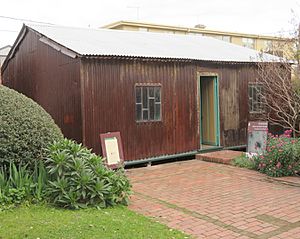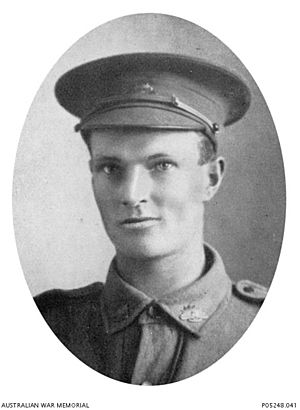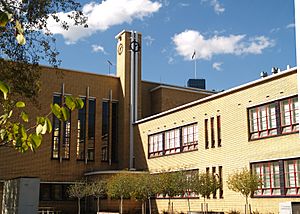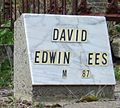Ailsa O'Connor facts for kids
Ailsa Margaret O'Connor (born Donaldson) (1921–1980) was an Australian artist. She was known for her sculptures and paintings, which looked very real (this style is called realism). Ailsa believed that art and artists should care about society and politics. She worked hard to fight against unfairness in Australia and other countries, especially for women's rights.
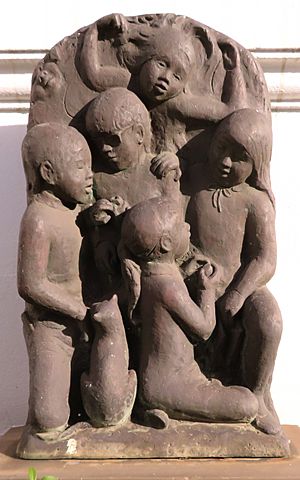
Contents
Ailsa O'Connor's Family History
The discovery of gold in Australia became widely known in 1851. This led to many people arriving in Australia over the next 10 years. Ailsa O'Connor's family members were among them. They came from Ireland, Wales, and Scotland. Most of them settled in the area that is now the state of Victoria.
Her Mother's Family – From Maldon
Ailsa O'Connor's mother's family arrived in Australia in 1862. Her ancestor, William David (1835–1904), was a coal miner from Neath, Wales.
William David, his Welsh wife Ann Walters (1836–1899), and their two young children settled in Maldon, Victoria. There, William continued mining, but for gold instead of coal. At that time, gold miners were starting to form the first trade unions. They wanted better working conditions, like an eight-hour workday and improved safety. The Maldon Museum has an old banner from one of these early unions.
William and Ann David lived most of their lives in Maldon. Many of their children and grandchildren also lived there. They are all buried in the Maldon Cemetery.
William David's son, Alfred, married Amelia Jane Birmingham (1862–1942). Amelia's Irish father was also a miner in Maldon. Her mother was English.
School records show that Amelia Jane Birmingham started Maldon State School in 1874, when she was 12. Her daughter, Amelia Jane David (known as Millie), started school there in 1888.
Margaret Flora David (1888–1968) was the fourth of their 12 children born in Maldon.
In 1915, Margaret Flora David married Ralph Charles Donaldson (1888–1955). She left Maldon and moved with him to his hometown, Heyfield in Victoria.
Ralph worked as a labourer. When he was 40, he learned how to be a baker. His family then moved to Portland in south-west Victoria. They soon ran a bakery there. The old bakery building is now a bank. It is a protected historical site.
Her Father's Family – From Heyfield
Ailsa's father's family were stonemasons from Airdrie, North Lanarkshire in Scotland. David Donaldson (1820–1886) left Scotland for America. Then, around 1852, he joined the gold rush in Melbourne, Victoria. He married another Scot, Annie Thomson (1826–1906), and started his own stonemason company.
For five years, the Donaldsons lived in a special pre-made iron house in North Melbourne. This house is now a protected historical building.
In the 1860s, new gold rushes happened east of Melbourne. The Gippsland area attracted gold seekers and farmers. It also brought people who provided services to locals and travelers.
David Donaldson and his family moved east. They opened a general store first in Matlock. In 1878, they moved the store to Morwell. David stayed there until he passed away in 1886.
His wife, Annie, and their two youngest sons continued to run the store for over 10 years. Later, Annie moved back to Melbourne for her health. Her sons traveled across Australia to another gold area, Coolgardie, Western Australia. Annie's daughter, Agnes, had already settled in Western Australia in 1894.
Meanwhile, two other of David Donaldson's children moved to nearby Aberfeldy. His oldest daughter, Elizabeth, married an Irish butcher there in 1879. Soon after, her brother Henry became the postmaster in the village.
Elizabeth passed away in 1884, and her husband passed away in 1885. Their three orphaned children lived with their grandparents, David and Annie Donaldson, in Morwell. The oldest child, John Patrick Dwyer, was very smart and good at sports. He later became the Chief Justice of Western Australia and received a special honor (knighthood).
When Elizabeth died, her brother Henry Donaldson and his family moved from Aberfeldy to Heyfield. Henry was the postmaster there until 1896. His wife, Elsie, then took over as postmistress for five years.
Heyfield remained their home. Their third son, Ralph Charles, lived there for many years with his mother Elsie, his wife, and three daughters. They moved to Portland in 1928.
War Heroes, 1914–1918
Two of Annie Donaldson's sons fought in World War I. Her grandson, John Patrick Dwyer, also served.
Ralph Charles Donaldson was 27 when he joined the army. He was a driver in the 2nd Australian Division Signals Company from 1915 to 1919. He fought in many places. He received the Distinguished Conduct Medal in 1916. This was for his bravery in keeping important communication lines working during heavy fighting.
Henry Archibald ("Archie") Donaldson joined the army in 1916, at age 29. He was a school teacher. As a soldier in the 58th Australian Infantry Battalion, he fought in many battles. He was killed in battle in France in 1917. He is buried in a military cemetery there.
Their cousin, John Patrick Dwyer, also joined the army at age 35. He became a lieutenant within a year. He returned to Australia after the war ended.
Ailsa's Childhood and Education
Ailsa Donaldson grew up in Heyfield and Portland, where her parents lived. She went to school in both towns. For her final year of school, she moved to Melbourne. She attended Mac.Robertson Girls High School. There, she did very well, especially in Art and English.
Ailsa recalled starting her art education in 1937: "I left home at fifteen, was at school in Melbourne, and at sixteen started an art course at Royal Melbourne Institute of Technology. I had a scholarship that paid for my studies. I studied art and also trained to be a teacher. I went to classes every night. By the time I was nineteen, I was teaching large classes of boys in Brunswick. Their classrooms were needed for air force trainees during the war."
World War II affected many parts of Australian life. There were shortages and dangers at home. People worried about soldiers fighting overseas. Six of Ailsa's male relatives fought overseas. Her aunt, Annie Ethel Warren, joined the Army Citizen Military Forces in Melbourne at age 50.
Ailsa Donaldson married during the war. Her husband was another artist named Victor George O'Connor. He joined the Army Citizen Military Forces and became a Sergeant. Ailsa then took her husband's last name, becoming Ailsa O'Connor.
Ailsa O'Connor's Artistic Life
In 1938, a new art group called the Contemporary Arts Society of Victoria (CAS) started in Melbourne. Ailsa Donaldson, who was 16, was one of its first members. She regularly showed her paintings and drawings in their exhibitions. While other women artists were in the group, Ailsa was unique. She joined the "social realist" artists who focused on society and politics. She was the only woman to show art in the 1942 "Anti-Fascist Exhibition" in Melbourne. Sadly, all her paintings from the war years are now lost.
Julie Copeland, a radio presenter, wrote about Ailsa O'Connor's work. She said that Ailsa cared deeply about people who were poor or treated unfairly. Julie noted that Ailsa's political work took up a lot of her time and energy. This meant she had less time to develop her art.
Ailsa also had other big responsibilities. She worked full-time as a high school teacher and headmistress for 15 years, until 1970. She was also a mother.
Her time was even more stretched by her involvement in the rise of "Second Wave Feminism" in the 1960s and 1970s. This movement worked for women's rights. Her work as a feminist had a lasting impact. For example, the Women's Art Register, which helps record women's art, started in 1975. Ailsa O'Connor helped create many important groups that are still active today.
She also found time to write long newspaper articles and papers about art and current issues. She reviewed books by other artists. In 1975, she reviewed a book about artist Noel Counihan. She wrote about a question that was important to her: "Perhaps we women are becoming more aware of the difference between fantasy, role, and reality, or perhaps it is just that no artist has yet produced a convincing image of contemporary woman." She was looking for art that truly showed modern women.
Here is a summary of Ailsa O'Connor's public activities, from her early adult life until her death in 1980:
Exhibitions
O'Connor showed her paintings, drawings, linocuts, and sculptures in exhibitions in Melbourne. Some examples include:
- 1938 – around 1942: Exhibitions with the Contemporary Art Society.
- 1950s & 1960s: Exhibitions with the Realist Group, Melbourne. Other members included Noel Counihan and Mary Hammond.
- 1971: An exhibition with Mary Hammond.
- 1975: A solo exhibition of her sculptures and drawings at the Russell Davis Gallery.
- 1978: A group exhibition of printmakers at the McClelland Regional Gallery.
- 1979: An exhibition with Mary Hammond at the Trades Hall Gallery.
- 1989: A special exhibition of her work after her death at the Niagara Galleries.
Memberships
O'Connor actively supported causes she believed in. She was a member of:
- 1944–1980: The Communist Party of Australia.
- 1950–1955: The Union of Australian Women. She was a founding member and Secretary.
- 1953: The World Congress of Women in Copenhagen. She represented the Union of Australian Women from Victoria.
- 1953–1956: The Asian Australian Child Art Exchange. She started and organized this program.
Art in Public Galleries
Most of O'Connor's artworks are in private collections. However, some are also in Australian public art galleries:
- Tasmania Museum and Art Gallery, Hobart, Tasmania (2 artworks).
- National Gallery of Australia, Canberra, ACT (number to be confirmed).
- National Gallery of Victoria, Australia (1 linocut: 'Building the Stockade' from 1954).
- Art Gallery of New South Wales, Australia (also has the linocut mentioned above).
Art Awards Received
- 1945: First prize in the 'Women in Industry’ section of the 'Australia at War' exhibition.
- 1953: First prize in the May Day Art Competition.
- 1979: Winner of the Caulfield City Council Invitation Art Award.
- 2001: She was honored after her death by being added to the Victorian Honour Roll of Women.
Supplementary pictures
Maldon Cemetery – the David family graves
The Conservatory, Fitzroy Gardens, Melbourne – O'Connor sculpture of Mary Gilbert



